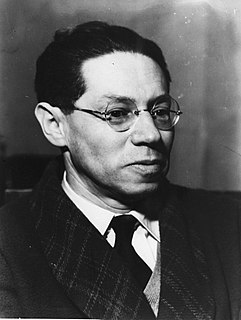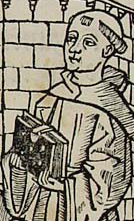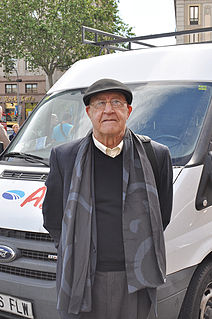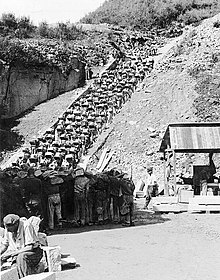
Mauthausen was a Nazi concentration camp on a hill above the market town of Mauthausen, Upper Austria. It was the main camp of a group with nearly 100 further subcamps located throughout Austria and southern Germany. The three Gusen concentration camps in and around the village of St Georgen/Gusen, just a few kilometres from Mauthausen, held a significant proportion of prisoners within the camp complex, at times exceeding the number of prisoners at the Mauthausen main camp.

Lion Feuchtwanger was a Bavarian Jewish novelist and playwright. A prominent figure in the literary world of Weimar Germany, he influenced contemporaries including playwright Bertolt Brecht.

The Unified Socialist Party of Catalonia was a communist political party active in Catalonia between 1936 and 1997. It was the Catalan branch of the Communist Party of Spain and the only party not from a sovereign state to be a full member of the Third International.

Joaquim Amat-Piniella was a Catalan writer. He is best known for his semi-autobiographic novel K.L. Reich, based on his experience as a prisoner in the Mauthausen concentration camp during the Second World War.

Enric Marco is an impostor who claimed to have been a prisoner in Nazi German concentration camps Mauthausen and Flossenbürg in World War II. He was awarded the Creu de Sant Jordi by the Catalan government in 2001 and wrote a book on his experiences. In 2005 he admitted his claims were false and returned his medal, after his deception was revealed by university researcher Benito Bermejo.
The Holocaust has been a prominent subject of art and literature throughout the second half of the twentieth century. There are a wide range of ways – including dance, film, literature, music, and television – in which the Holocaust has represented in the arts and popular culture.

Francesc Eiximenis was a Franciscan Catalan writer who lived in the 14th-century Crown of Aragon. He was possibly one of the more successful medieval Catalan writers since his works were widely read, copied, published and translated. Therefore, it can be said that both in the literary and in the political sphere he had a lot of influence. Among his readers were numbered important people of his time, such as the kings of the Crown of Aragon Peter IV, John I and Martin I, the queen Maria de Luna, and the Pope of Avignon Benedict XIII.

Centre d'Esports Sabadell Futbol Club, S.A.D. is a Spanish football team based in Sabadell, a city in the province of Barcelona in the autonomous community of Catalonia. Founded in 1903, it plays in Primera División RFEF – Group 2, holding home games at Estadi de la Nova Creu Alta.

Francesc Boix Campo was a veteran of the Spanish Civil War and photographer who was imprisoned in the Mauthausen concentration camp. At the Nuremberg and Dachau trials he presented photographs that played a role in the conviction of Nazi war criminals.

Aribert Ferdinand Heim, also known as Dr. Death and Butcher of Mauthausen, was an Austrian Schutzstaffel (SS) doctor. During World War II, he served at the Mauthausen-Gusen concentration camp in Mauthausen, killing and torturing inmates using various methods, such as the direct injection of toxic compounds into the hearts of his victims.
Anna Aguilar-Amat is a Catalan poet, translator, researcher and university professor in Terminology and Computational Linguistics. She writes primarily in Catalan but also has some work in Spanish. She has a PHD from the Universitat Autònoma de Barcelona where she now teaches Terminology applied to Translation at the Translation Faculty. She published five collections of poems and has received several awards for Catalan poetry. Her poetic work is present in several anthologies of Catalan poets and she has been translated into Spanish, English, French, Italian, Sardinian, Macedonian, Finnish, Arabian, Turkish, Greek, German and Slovenian. She was included in the Anthology New European Poets by Wayne Miller & Kevin Prufer, Minnesota 2008.
Serra d'Or is a Catalan magazine that appeared in October 1959. It was promoted by a group of university students, and was published by the Montserrat abbey press, with a monthly circulation of 8.000 copies.

Emili Teixidor i Viladecàs was a Catalan writer, journalist and pedagogue. He wrote over thirty novels, mainly for children and teenagers, but he is perhaps best known for his acclaimed adult novel, Black Bread, which inspired a film of the same name.

Hans Maršálek was an Austrian typesetter, political activist, detective, and historian. A devout socialist and active in the resistance, he was arrested by the Nazis and imprisoned in the Mauthausen concentration camp. After the war, he joined the Austrian political police and was instrumental in tracking down and convicting numerous Nazi criminals. He also became the main chronicler of the camp's history, helped establish the Mauthausen Memorial Museum, and published several books.

Josep Coll i Martí, better known as Pep Coll, is a Spanish writer. A prolific author, he has cultivated all literary genres, including journalism. His life and literary world are the Pyrenees, which have become a legendary universe. His works have been translated into several languages, including Spanish and Basque. In addition to his work as a writer, he has been teacher of language and literature.

The Photographer of Mauthausen is a 2018 Spanish biography drama historical film directed by Mar Targarona starring Mario Casas, Macarena Gómez, and Alain Hernández. The film tells the history of the photographer Francisco Boix during his life in the Mauthausen-Gusen concentration camp complex.

Gusen was a subcamp of Mauthausen concentration camp operated by the SS between the villages of Sankt Georgen an der Gusen and Langestein in the Reichsgau Ostmark. Primarily populated by Polish prisoners, there were also large numbers of Spanish Republicans, Soviet citizens, and Italians. Initially, prisoners worked in nearby quarries, producing granite which was sold by the SS company DEST.
The Maria Àngels Anglada Prize is a Catalan literary award, given annually by the Institut Ramon Muntaner, in Figueres (Spain), with the aim of contributing to the promotion of Catalan literature, reaffirming the civic and cultural projection of the school and extolling the memory of the writer Maria Àngels Anglada, ex-professor of the centre. The award has the support of the Geli-Anglada family and the sponsorship of the Ajuntament de Figueres and the Diputació de Girona, as well as the collaboration of the Consell Comarcal de l'Alt Empordà.
Francesc Trabal was a Catalan novelist, journalist and humorist.
















